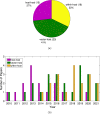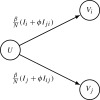Mathematical models for dengue fever epidemiology: A 10-year systematic review
- PMID: 35219611
- PMCID: PMC8845267
- DOI: 10.1016/j.plrev.2022.02.001
Mathematical models for dengue fever epidemiology: A 10-year systematic review
Abstract
Mathematical models have a long history in epidemiological research, and as the COVID-19 pandemic progressed, research on mathematical modeling became imperative and very influential to understand the epidemiological dynamics of disease spreading. Mathematical models describing dengue fever epidemiological dynamics are found back from 1970. Dengue fever is a viral mosquito-borne infection caused by four antigenically related but distinct serotypes (DENV-1 to DENV-4). With 2.5 billion people at risk of acquiring the infection, it is a major international public health concern. Although most of the cases are asymptomatic or mild, the disease immunological response is complex, with severe disease linked to the antibody-dependent enhancement (ADE) - a disease augmentation phenomenon where pre-existing antibodies to previous dengue infection do not neutralize but rather enhance the new infection. Here, we present a 10-year systematic review on mathematical models for dengue fever epidemiology. Specifically, we review multi-strain frameworks describing host-to-host and vector-host transmission models and within-host models describing viral replication and the respective immune response. Following a detailed literature search in standard scientific databases, different mathematical models in terms of their scope, analytical approach and structural form, including model validation and parameter estimation using empirical data, are described and analyzed. Aiming to identify a consensus on infectious diseases modeling aspects that can contribute to public health authorities for disease control, we revise the current understanding of epidemiological and immunological factors influencing the transmission dynamics of dengue. This review provide insights on general features to be considered to model aspects of real-world public health problems, such as the current epidemiological scenario we are living in.
Keywords: Antibody dependent-enhancement; Dengue fever; Mathematical models; Multi-strain; Vector-host; Within-host.
Copyright © 2022 Elsevier B.V. All rights reserved.
Conflict of interest statement
Declaration of Competing Interest The authors declare that they have no known competing financial interests or personal relationships that could have appeared to influence the work reported in this paper.
Figures






References
-
- Fischer D.B., Halstead S.B. Observations related to pathogenesis of dengue hemorrhagic fever. V. Examination of agspecific sequential infection rates using a mathematical model. Yale J Biol Med. 1970;42(5):329–349. https://pubmed.ncbi.nlm.nih.gov/5419207 - PMC - PubMed
-
- Johansson M.A., Hombach J., Cummings D.A. Models of the impact of dengue vaccines: a review of current research and potential approaches. Vaccine. 2011;29(35):5860–5868. https://www.sciencedirect.com/science/article/pii/S0264410X11009066 - PMC - PubMed
-
- Andraud M., Hens N., Marais C., Beutels P. Dynamic epidemiological models for dengue transmission: a systematic review of structural approaches. PLoS ONE. 2012;7(11) https://journals.plos.org/plosone/article?id=10.1371/journal.pone.0049085 - PMC - PubMed
-
- Pan American Health Organization Aedes aegypti: biology and ecology. https://iris.paho.org/bitstream/handle/10665.2/28514/PNSP8664_eng.pdf?se... Retrieved from.
-
- World Health Organization Dengue and severe dengue - key facts. https://www.who.int/news-room/fact-sheets/detail/dengue-and-severe-dengue Retrieved from.
Publication types
MeSH terms
Substances
LinkOut - more resources
Full Text Sources
Medical

